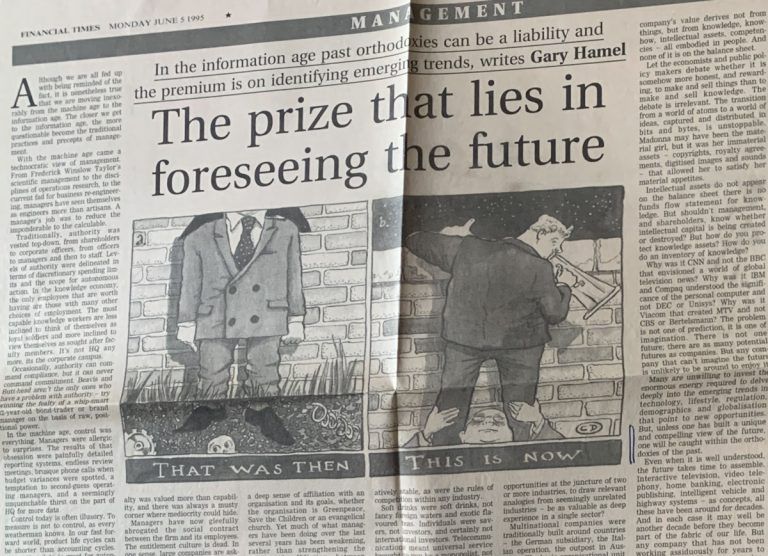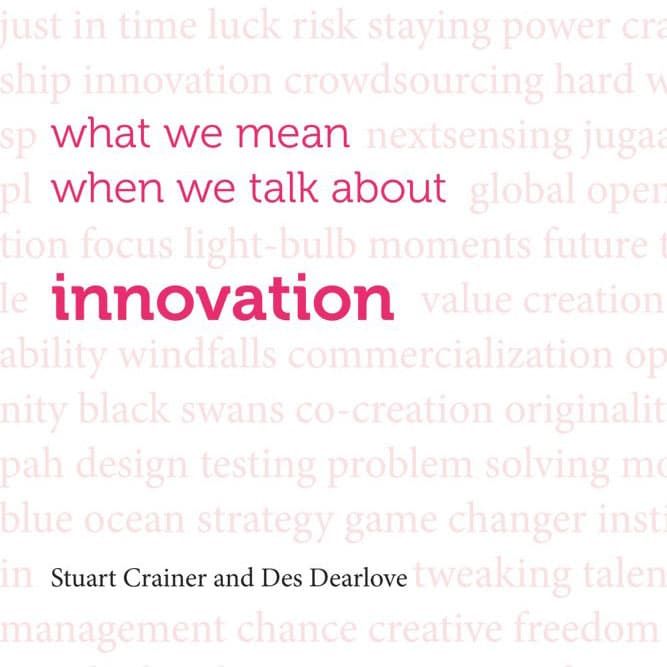

One of the most insightful and entertaining thinkers on innovation is the Finnish academic Alf Rehn. For the past five years, Rehn’s work has focused specifically on why organizations (institutions and even entire societies) that believe they have a grasp of what innovation requires frequently fail to utilize its full potential. He has studied hundreds of companies, innovation projects, strategic initiatives and policies, diagnosing how and why they can fail — and how they could have been salvaged. Rather than looking at a series of cherry-picked cases of best practice, he has adopted a clinical, no-nonsense approach to innovation; one that doesn’t shy away from the problems and pitfalls.
Rehn’s arguments ring true. At their heart is a feeling of dissatisfaction with the practice of innovation in organizations. Executives on the innovation front-line agree. A much-publicized report from McKinsey found that 94 percent of managers expressed dissatisfaction with innovation performance in their organizations. Similarly, policy-makers worldwide have lamented disappointing results from the massive global spending on innovation. This at a time when innovation may be needed more than ever. And when corporations and nations invest vast sums in innovation (more than two trillion US dollars in 2015).
“Studying innovation is not easy,” lamented Rehn over a latte when we talked in London. “There is no absolute definition of what constitutes an innovation. Nor are there generally accepted metrics for measuring innovative capability. Establishing exactly what led to a new solution can be both time-consuming and frustrating, and we know far too little about how innovation projects fail. Rarely has the old adage of ‘Success has many fathers, failure is an orphan’ been more apt than in the study of innovation.”
Innovation needs to be saved, argues Rehn. He suggests that some companies are already playing their part in making this happen.
He provides three quick examples of the new best practice which gives hope.
Consider the Finnish company Konecranes. As it evolved into a global corporation, the manufacturer of cranes and heavylifting equipment realized it had to stop talking about innovation, and focus instead on what was holding innovation back. By learning to implement ideas even when they did not live up to the stereotypical image of “real innovation,” and by letting in people who cared more about making a difference than quoting Steve Jobs, the company went beyond preconceived notions of how innovation happens, discovering that a hackathon can beat any number of innovation conferences.
Or take the example of Montana Tech Components. Led by a charismatic CEO/owner, this classic example of Mittelstand (mid-sized company) works in areas seen as boring, conservative, and decidedly unsexy. Driven on by a CEO who cares more about making an impact than getting good PR, the company excels in challenging markets and generates a huge number of novel products – pushing far beyond what their customers thought “innovation” could be.
And then there’s the unlikely story of Sanergy. Despite working in the field of sanitation, this African company accepts no (innovation) bullshit. By turning sanitation into a hotbed of micro-entrepreneurship, Sanergy shows how meaningful innovation can be translated into a nimble, sustainable business, in the most difficult of circumstances, and far away from the land of innovation keynotes.
In another case, a company decided to outlaw the word “innovation” and radically scale back its development budget, only allowing for very limited windows during which development ideas and projects could be suggested and implemented. As a result, the company saw a radical increase both in employee satisfaction, the quality of its innovation projects, and the value generated by these.
These exemplars, suggests Alf Rehn, shouldn’t blind us to the reality that work needs to be done. A lot of work. He maps out how high the stakes are: “The capacity for innovation is a critical success factor both for companies planning to survive ongoing market upheaval, and for countries attempting to adapt to the megatrends facing society.”
Rehn goes onto map out the problem, as he sees it: “At the same time, innovation has become a buzzword; a cure-all for any problem facing organizations and society. Along the way, true innovation has been reduced to a caricature of itself – a supposedly simple, color-by-numbers exercise that can be bolstered with peppy posters, cheerful consultants, and technicolor team-building exercises.
“In many organizations an all-too-familiar pattern can be seen. As more and more attention is paid to fewer and fewer kinds of innovation, a myopia sets in, followed by other management maladies. In many organizations this has led to a watering down of the potential of innovation, with the attendant downward trajectory for returns on innovation.”
Having said this with a characteristic roll of his eyes, Rehn provides a positive parting shot: “All is not lost! Many of the disappointing results are due to a cultural and organizational malaise, one that can be counteracted. With the right sort of leadership, the courage to look clinically at the problems of innovation, and the commitment to reclaim it from the buzzwords and the slogans innovation can be made meaningful once again.
“In fact, with the technologies and resources at our disposal, a revitalized discourse and culture of innovation can help us elevate both our companies and society itself to hitherto unimagined levels.” Innovation is the future.
Resources
Alf Rehn, Dangerous Ideas, Marshall Cavendish, 2011.
www.alfrehn.com
This was originally published in What we mean when we talk about innovation by Stuart Crainer and Des Dearlove (Infinite Ideas, 2016).

Thinkers50 Limited
The Studio
Highfield Lane
Wargrave RG10 8PZ
United Kingdom

Thinkers50 Limited
The Studio
Highfield Lane
Wargrave RG10 8PZ
United Kingdom

Thinkers50 Limited
The Studio
Highfield Lane
Wargrave RG10 8PZ
United Kingdom
| Cookie | Duration | Description |
|---|---|---|
| LANG | 9 hours | Linkedin set this cookie to set user's preferred language. |
| nsid | session | This cookie is set by the provider PayPal to enable the PayPal payment service in the website. |
| sp_landing | 1 day | The sp_landing is set by Spotify to implement audio content from Spotify on the website and also registers information on user interaction related to the audio content. |
| sp_t | 1 year | The sp_t cookie is set by Spotify to implement audio content from Spotify on the website and also registers information on user interaction related to the audio content. |
| tsrce | 3 days | PayPal sets this cookie to enable the PayPal payment service in the website. |
| x-pp-s | session | PayPal sets this cookie to process payments on the site. |
| __cf_bm | 30 minutes | This cookie, set by Cloudflare, is used to support Cloudflare Bot Management. |
| Cookie | Duration | Description |
|---|---|---|
| l7_az | 30 minutes | This cookie is necessary for the PayPal login-function on the website. |
| Cookie | Duration | Description |
|---|---|---|
| CONSENT | 2 years | YouTube sets this cookie via embedded youtube-videos and registers anonymous statistical data. |
| _ga | 2 years | The _ga cookie, installed by Google Analytics, calculates visitor, session and campaign data and also keeps track of site usage for the site's analytics report. The cookie stores information anonymously and assigns a randomly generated number to recognize unique visitors. |
| _gat_gtag_UA_10408481_1 | 1 minute | Set by Google to distinguish users. |
| _ga_ZP8HQ8RZXS | 2 years | This cookie is installed by Google Analytics. |
| _gid | 1 day | Installed by Google Analytics, _gid cookie stores information on how visitors use a website, while also creating an analytics report of the website's performance. Some of the data that are collected include the number of visitors, their source, and the pages they visit anonymously. |
| Cookie | Duration | Description |
|---|---|---|
| NID | 6 months | NID cookie, set by Google, is used for advertising purposes; to limit the number of times the user sees an ad, to mute unwanted ads, and to measure the effectiveness of ads. |
| test_cookie | 15 minutes | The test_cookie is set by doubleclick.net and is used to determine if the user's browser supports cookies. |
| VISITOR_INFO1_LIVE | 5 months 27 days | A cookie set by YouTube to measure bandwidth that determines whether the user gets the new or old player interface. |
| YSC | session | YSC cookie is set by Youtube and is used to track the views of embedded videos on Youtube pages. |
| yt-remote-connected-devices | never | YouTube sets this cookie to store the video preferences of the user using embedded YouTube video. |
| yt-remote-device-id | never | YouTube sets this cookie to store the video preferences of the user using embedded YouTube video. |
| yt.innertube::nextId | never | This cookie, set by YouTube, registers a unique ID to store data on what videos from YouTube the user has seen. |
| yt.innertube::requests | never | This cookie, set by YouTube, registers a unique ID to store data on what videos from YouTube the user has seen. |
| Cookie | Duration | Description |
|---|---|---|
| DEVICE_INFO | 5 months 27 days | No description |
| loglevel | never | No description available. |
| m | 2 years | No description available. |
Thinkers50 Limited has updated its Privacy Policy on 28 March 2024 with several amendments and additions to the previous version, to fully incorporate to the text information required by current applicable date protection regulation. Processing of the personal data of Thinkers50’s customers, potential customers and other stakeholders has not been changed essentially, but the texts have been clarified and amended to give more detailed information of the processing activities.